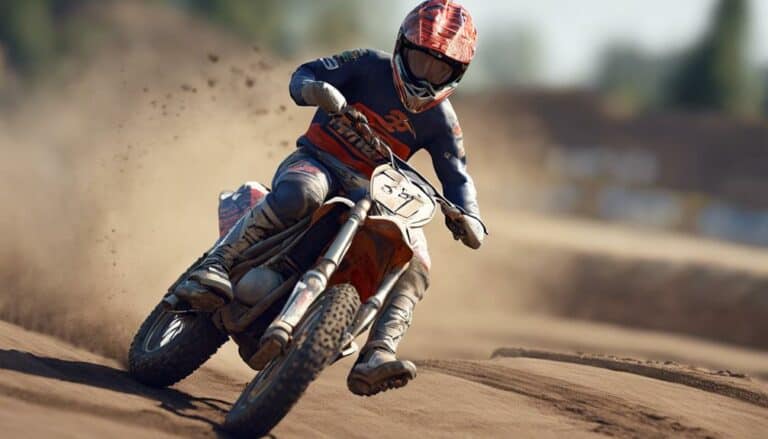When it comes to maneuvering the twists and turns of dirt trails, mastering the art of braking on a dirt bike is essential for your safety and performance.
You might already be familiar with the basic principles, but have you considered the nuances of weight distribution and timing that can take your braking skills to the next level? Understanding the different braking techniques and how to apply them effectively is not just about stopping; it's about controlling your ride with precision and finesse.
So, let's explore the intricacies of braking techniques for dirt bikes and elevate your off-road experience to new heights.
Key Takeaways
- Utilize front brake lever for 70% braking power and adjust position for responsiveness.
- Balance front and rear brake usage for control and stability.
- Use engine braking and proper gear selection for speed control.
- Optimize braking points by adjusting markers for efficiency and analyzing lap times.
Importance of Front Brake
Mastering the effective utilization of the front brake is paramount for maximizing control and stopping power on a dirt bike. The front brake lever is your primary tool for deceleration, providing approximately 70% of the braking power.
To optimize braking power, apply firm but smooth brake pressure using one finger on the lever. Proper body position is vital; shift your weight slightly to the rear to prevent the front wheel from locking up.
By trusting the front brake for the majority of your braking needs, around 90%, you can achieve improved performance and control. Adjusting the front brake lever position to suit your preference can enhance responsiveness and overall braking skills.
Remember that consistent use of the front brake may lead to faster pad wear compared to the rear brake. Embrace the front brake as your ally, and with practice, you'll harness its potential for maximum control and stopping efficiency on the dirt track.
Utilizing Rear Brake Effectively
When tackling challenging terrain on a dirt bike, it's essential to effectively utilize the rear brake for maintaining control and stability, especially in braking bumps. To perfect your braking technique, focus on using the rear brake pedal low to the ground to maximize the bike's stopping power.
Remember, the front brake provides the majority of the braking force, so make sure you're also braking hard enough with it to balance the braking forces between the front and rear wheels.
As you apply the brakes, make sure to use the rear brake in conjunction with the front brake and clutch to smoothly modulate your speed. By utilizing the rear brake judiciously, you can prevent skidding and maintain directional control.
Additionally, remember to let your knees and legs absorb the impacts during braking bumps to enhance stability and control while riding off-road.
Mastering the art of using the back brake effectively won't only extend the life of your rear brake pads but also optimize your overall braking performance on dirt bikes.
Understanding Engine Brake Usage
Understanding the principles of engine braking enhances your control over speed and traction in various riding conditions. Engine braking involves leveraging the resistance of the engine to decelerate the bike by downshifting instead of solely relying on the brakes. This technique is particularly useful for controlling speed on descents or slippery terrain, reducing the need for excessive use of traditional braking methods.
To apply engine braking effectively, it's essential to select the appropriate gear that matches the terrain and RPM range to achieve the desired speed reduction smoothly.
Proper use of engine braking can help prevent wheel lock-up and maintain traction, especially when riding in off-road conditions where maintaining control is essential. Mastering engine braking not only enhances riding control but also contributes to reducing wear on brake components over time.
Mastering Braking Points
To optimize your cornering efficiency on the track, adjusting braking points based on the current track conditions and your bike setup is essential. Gradually move your braking markers forward to find the ideal point for maximum speed and control. Braking too early can hinder your overall performance, so it's critical to practice adjusting your braking points for best results.
In competitive racing, understanding the relationship between braking points and speed is paramount. Analyzing your lap times can help you determine the impact of braking point optimization on your overall performance. By mastering your braking points, you can fine-tune your cornering efficiency and ultimately improve your competitiveness on the track.
Techniques for Braking While Cornering
Braking while cornering on a dirt bike requires precise control and strategic use of both brakes to maintain stability and optimize maneuverability through turns. To enhance your cornering skills, follow these techniques:
- Use both brakes: Apply the front and rear brakes smoothly to control your speed and maintain balance without risking wheel lock-up.
- Adjust body positioning: Stand on the pegs, lean your body back, and keep your weight centered to improve braking control and stability through corners.
- Brake as late as possible: By braking later into the corner, you can reduce your braking distance and potentially improve your lap time.
- Throttle control: Manage your throttle input along with braking to make a smooth change and maintain control over the front end of the bike.
Mastering these techniques won't only help you navigate corners more effectively but also enhance your overall dirt biking experience.
Conclusion
In summary, mastering the different braking techniques for dirt bikes is vital for safe and efficient riding. By mainly relying on the front brake for stopping power and using the rear brake for control, riders can navigate various terrains with confidence.
Understanding the nuances of engine braking and optimizing braking points for cornering efficiency are key elements in achieving peak performance. Practice and precision are essential in honing these skills to elevate your dirt biking experience.

